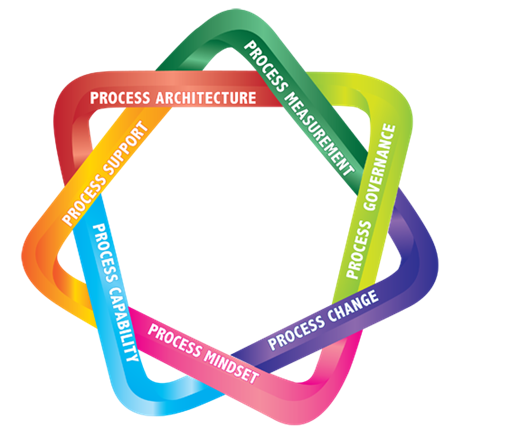Enabling the increasingly impossible demand to do even more with even less. We traditionally manage organisations via the template laid out by the organisation chart. Yet not one of the entities shown on any organisation chart can deliver value to an external customer by itself. The reality is that we create, accumulate and deliver value by collaboration across the organisation chart. We manage resources vertically using the organisation chart. We create and deliver value horizontally across the organisation, and the key management artefact should be the business process architecture.
 Roger Tregear, Consulting Director, Leonardo Consulting
Roger Tregear, Consulting Director, Leonardo Consulting
Roger will be presenting a workshop on: Process-Based Management: Putting Process at the Centre of Business Management at IRM UK’s co-located BPM Conference Europe 2016 & EA Conference Europe 2016, 13-16 June, London.
In times when most organisations are under considerable pressure to simultaneously reduce costs, enhance products and services, and be more attentive to customers, process-based management offers a practical solution. Process-based management, more commonly known as Business Process Management (BPM), refocuses management on how value is delivered to customers and other stakeholders. The focus is on the way work gets done and what impedes it being done in the most straightforward, efficient and effective way.
This describes seven enablers that put process at the centre of business management.
An Impasse
The time has passed when improving performance can be achieved by ‘simply’ reducing budgets and assuming that those affected will adjust to the change. After years of budget cuts and efficiency dividends, the easy changes are done, contingency resources are extinct, and further change is deep, structural and difficult. Resource scarcity dominates decision making, and the need to ‘do more with less’ seems both inevitable and impossible.
The predictable results of repeated, untargeted, broad-based reductions in available resources are often reduced service levels, extended delays, increased personal and team stress, and a general reduction in organisational performance. Unfocused reductions cause dysfunction, not efficiency. Short term gains in the current financial year might mask the accumulating pain, but they can neither avoid nor remove it.
Across the spectrum of public, private and not-for-profit sectors, many organisations are faced with the complex dilemma of dealing effectively with major operational challenges such as radically increased customer expectations, snowballing cost pressures, shrinking budgets, mounting regulatory compliance, diminishing staff numbers, increasing operational complexity, and fragile workforce enthusiasm.
A repeated cycle of job cuts cannot provide the ultimate sustainable answer. A recent newspaper article provided a chilling insight into contemporary corporate life: “Staff in the department have been told that budget cuts inflicted by the government have made the job cuts ”an urgent task” and they have been warned of even more pain to come.” That comment refers to an Australian public sector agency, but many in other countries and in the private sector will find the general circumstances disturbingly familiar. ( Towell, Noel. 2013. “Public servants told 400 must go.” The Canberra Times, August 15. 13. http://www.canberratimes.com.au/national/public-service/public-servants-told-400-must-go-20130814-2rx8t.html )
In the real world there may have to be some job cuts, but that can no longer be the only, or even main, response to the requirement to do more with less. There also has to be a more nuanced response that focuses on doing the necessary work as efficiently as possible, removing the wasted time and costs, being much more forensic in the discovery of effective change, and continuously realising sustainable benefits. A new culture of process innovation and improvement is needed.
A government regulatory agency recently increased the number of compliance inspections it was able to achieve by 500% without any change in workforce. It achieved this by better understanding the related business processes, carefully removing unnecessary steps, redesigning to eliminate delays, enhancing stakeholder education, and automating some (but not all) activities.
There is a better way. Look around your organisation. Can you see areas where work could be done more efficiently and effectively? We all can, and we should do something about it.
So, what can we do?
This describes the theory and practice of process-based management. More commonly known as Business Process Management (BPM), as long as you take the holistic view of BPM as being a management philosophy, this approach refocuses management on the ways an organisation delivers value to its customers and other stakeholders. The focus is on the way work gets done and what impedes it being done in the most straightforward, efficient and effective way. BPM is not about technology, it is not an IT solution, but a pragmatic management approach.
The approach described in this paper has been proven to work in organisations irrespective of size, industry sector, and circumstance. It’s not trivial to implement, but neither is it so difficult as to justify leaving it in the ‘too hard basket’.
There is no technical jargon in this paper. The discussion is based on common sense analysis of how work gets done. While the detail is left for another time, clear and practical suggestions are made as to how the 7Enablers of process-based management can be achieved, resulting in significant organisational performance improvement.
There are many examples where BPM approaches have delivered real operational benefits – reducing costs, innovating product and service delivery, disrupting business models, improving customer satisfaction, enhancing staff morale, and decreasing waste.
A corporation involved in the approval of service change requests was receiving serious complaints about the time taken to process applications. These complaints were coming from major stakeholders and the situation was critical. The complaints were justified as the data showed that while the average approval time was four weeks, it ranged from two to 20 weeks. Careful analysis and modelling of the business process, removal of delays, changes to work allocation, and improved applicant awareness all contributed to a dramatic improvement with complex applications now completed in six weeks, simple ones in two weeks, and both with a guaranteed variability limit of +/- one week.
Defining process-based management
Before moving to the substantive content of this paper, it is as well to first define the terms business process, process improvement and process management. These are key concepts and many different definitions, and understandings of them and approaches to them, can be found in the literature.
Business processes are collections of cross-functional activities. They describe the sequence of activities required to achieve some outcome. By definition, business processes are the only way any organisation can deliver value to customers and other stakeholders. By themselves, the separate functional areas of an organisation cannot deliver value to external parties. Test that idea – can you name an entity on your organisation chart that, by itself, can deliver value to an external customer? I know you can’t, nobody can.
An organisation’s resources are managed ‘vertically’ via the organisation chart. Value is created, accumulated and delivered ‘horizontally’ across the organisation chart.
Value is accumulated, not up and down the functional organisation as represented in an organisation chart, but across the organisation as the various parts collaborate to create, accumulate and deliver value in the form of a desired product or service.
Business Process Management (BPM) is not a one-off project, nor an IT system; it is a management philosophy.
It follows that an organisation executes its strategic intent via its business processes. The profound sequence from strategy to execution is shown below,
From Strategy to Execution
Organisations exist to deliver value to customers and other stakeholders – that’s strategy.
They do this via a series of coordinated activities across a number of functions of the organisation – that’s a process.
It is sensible to optimise these processes so they satisfy the requirements of customers and other stakeholders – that’s process improvement.
A coordinated view of performance of all processes by which an organisation delivers value, optimises performance – that’s process management.
Process management focuses organisations on activities that create the value delivery outcomes described by the strategy – that’s execution.
In this context where cross-functional processes are key to the delivery of value to customers and other stakeholders (including the organisation itself), the improvement and management of processes is critical to the optimisation of performance.
The definition, improvement, and management of business processes include all the resources involved in the execution of each process.
How organisations can achieve even more with even less by identifying, analysing, improving, and managing business processes is the subject of the rest of this paper.
Taking a business process view
Discovering, documenting, improving, and actively managing cross-functional business processes can expose significant opportunities for getting more work done with the same, or perhaps even fewer, resources.
The power of process-based management is in understanding how work gets done, and based on that understanding, eliminating impediments, streamlining activities, and removing waste. The focus is on how the process, including all of the people and resources involved, delivers value to the customer and other stakeholders. This cross-functional focus is missing in most organisations, where it is replaced with an internal management emphasis guided by the organisation chart.
There are seven elements that come together to support process-based management:
1. Discovery, understanding and documentation of the organisation’s processes in a hierarchical model – process architecture
2. Defining process performance measures and measurement methods, collecting and reporting performance data – process measurement
3. Reimagining, and responding to, process performance, innovation opportunities, and general process hygiene—process governance
4. Continuously finding ways to close process performance gaps by eliminating problems and capitalising on opportunities—process change
5. Creating an environment where the organisation, its people, and their teams are always conscious of the processes in which they participate – process mindset
6. Developing the tools and skills required throughout the organisation to identify, analyse, improve, and manage business processes – process capability
7. Providing the support required throughout the organisation to develop, sustain and realise the benefits of process-based management – process support.
These seven enablers are shown in Figure 1. below. A Mobius strip format is used to highlight the interdependencies between the elements.
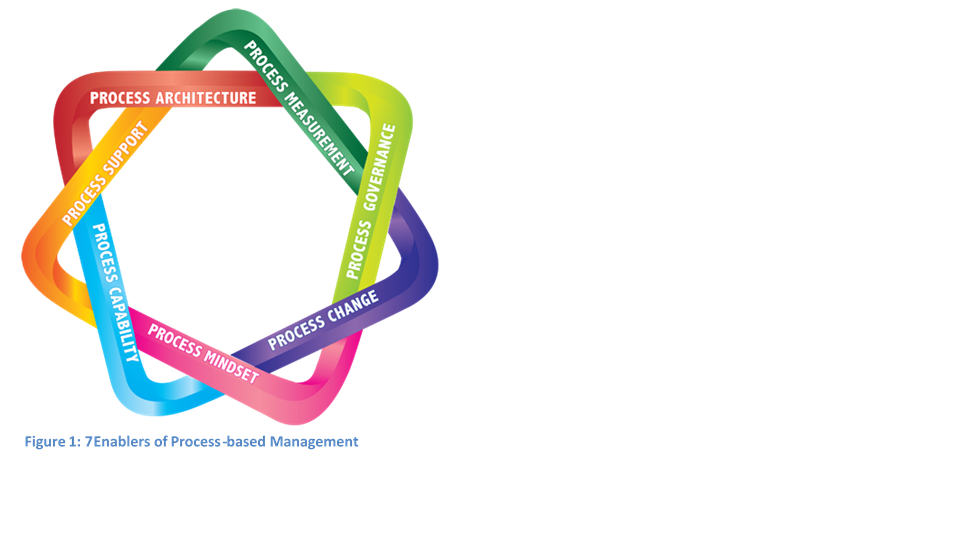
The core artefact is the process architecture since documenting the key processes is the necessary first step. Once documented, processes can be measured and once we have measures we need the governance arrangements to define who should respond to the performance reports. These first three enablers (architecture, measurement, governance) are the ‘physical infrastructure’ on which the rest is built. Continuous process improvement is the cornerstone of process-based management. Without process improvement, and its big brother process innovation, all else is waste. For process management and improvement to become ubiquitous, it must be embedded in the organisational mindset. Having a central specialist group to do all process work, does not scale and will soon impose a bizarre restriction on process management and improvement work. Therefore, it is necessary to build the capability for identifying, analysing, improving, and managing business processes throughout the organisation.
An overview of each of the seven enablers of process-based management is provided in the following sections.
Process Architecture
A business process architecture is a hierarchical model of the business processes of an organisation. Usually created, initially at least, to include the two or three highest levels, the process architecture provides a powerful visualisation and management tool.
The process architecture includes not just the hierarchical description of process activities, but also the related resources, documentation, performance measures, measurement methods, and governance arrangements.
The simple, but indicative, process architecture shown in Figure 2 is an abridged version of an architecture developed for an IT service vendor.
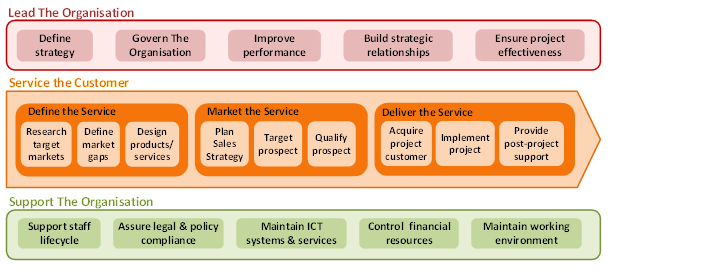
A well-formed process architecture is a powerful management and decision making tool and can be used to:
• Visualise the organisation’s set of business processes
• Understand how the organisation’s strategic intent is executed
• Communicate business process information
• Concentrate organisational focus on value delivery
• Understand the business process interdependencies
• Prioritise process analysis and improvement activity
• Coordinate process improvement project portfolio management
• Provide a repository of business process information
Process Measurement
If you don’t measure process performance, you can’t do process management – and you won’t know if you are doing process improvement.
The only reason for doing process analysis, improvement and management is to improve organisation performance in meaningful ways. Without measurement, we don’t know if there is improvement; we don’t know what is meaningful.
Business processes are the way an organisation delivers value to its customers. On that basis alone, the argument for measuring process performance is easily made. Are we delivering value to customers in a way that satisfies them and is sustainable for us? The plethora of measures about internal achievement – budget tracking, policy compliance, project completion, training attendance, people management, etc. – say little, if anything, about value delivery. Process performance says it all.
A government organisation implementing a new service did a lot of planning, created lots of process models, and had many sessions with a wide range of stakeholders. Green lights everywhere, so the service was launched with appropriate ‘ribbon cutting’. Two days later, everyone was relieved that the launch had gone well; two weeks later, there was a slowly rising murmur of complaint; two months later, service delivery was in virtual gridlock and the murmur was a cacophony. One month after that, it was finally discovered that a key process in the delivery of the service was often failing, causing significant rework and introducing inordinately long delays. Further analysis found a way to reduce these delays by 95%. After resolving the backlog, normal service delivery was resumed. However, customer and staff memories of the fiasco will never be erased. It didn’t need to be like that. Careful analysis of process performance expectations before launch, and appropriate measurement of process performance from launch, would have either avoided the problem, or detected it early and allowed resolution before it became a major issue.
Measuring business process performance delivers many benefits:
• Factual evidence of customer-service levels
• Better understanding of cross-functional performance
• Enable internal operational efficiency tracking
• Enhanced alignment of operations with strategy
• Evidence-based determination of process improvement priorities
• Detection of performance trends
• Better understanding of the capability range of a process
• Uncovering actual and latent problems
• Changing behaviour based on factual feedback
• Improved control over the risks that really matter
BPM initiatives that do not incorporate process measurement will fail. Process measurement is not always easy, but it is always possible.
Figure 3 shows the ProMeasure methodology, the Leonardo Consulting approach to detailed process performance development.
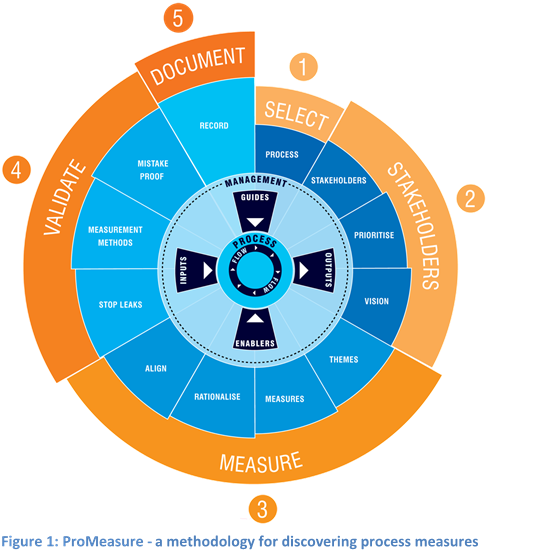
Process Governance
Governance is about the ‘management of process management’, describing how control is exercised over processes, both individually and collectively.
The concept of process governance is often misunderstood. A common implementation mode is to appoint people as Process Owners (or similar job title) and tell them they are responsible for the performance of their processes. This is almost certainly impossible. It is not reasonable to ask a Process Owner to be responsible for the performance of something, i.e. a cross-functional process, over which they have, at most, only partial control.
The key aspect of process governance is to have a plan for responding to process performance anomalies, and to have people tasked to execute such process performance interventions. Process governance is mainly about responding in an appropriate way to actual or emergent process performance anomalies. Without such response, the measurement of process performance is meaningless. Remember that the organisation chart is silent on the management of cross-functional processes.
Process Owners are accountable, not for the performance of the process, but for responding appropriately to process performance reports.
Governance mechanisms also deliver oversight of all activities and issues involved in achieving and maintaining the target performance for a process. This involves:
• Control of process change
• Guiding process development and promoting BPM ideas
• Updating process models and other documentation
• Resolving conflicts requiring trade-offs along the process
The ultimate outcome of effective process governance is proactive, efficient management, and continuous improvement, of the set of processes (and their subprocesses) by which an organisation delivers value to its customers and other stakeholders.
Process Change
Process improvement is at the heart of all process-based management activities. The main reason for taking a process view of an organisation is to improve business processes. In discovering, modelling and monitoring business processes, the main objective is to close performance gaps where cost-benefits can be proven.
Process change is what makes doing ‘more with less’ possible. Recruitment was proving to be very difficult for an organisation whose development plans were dependent on attracting new staff of considerable experience and expertise. However, often when an offer of employment was made it was found that the target of the offer had already taken another position. Over the previous 12 months this had happened in 73% of cases. This circumstance was jeopardising the achievement of an important strategic objective. Documenting the ‘Recruit Staff’ process and obtaining detailed performance data showed that it was taking, on average, 12 weeks from receipt of an application to the offer of a position. No wonder the good candidates had taken other offers. The process was analysed in detail with a particular focus on eliminating wasted time. As a result, the average cycle time of Recruit Staff was reduced from 12 weeks to three weeks. None of the process changes required any IT development or modification, but rather changes in the flow of paperwork, greater awareness of the impact of delays, removal of unnecessary steps, streamlining of approval stages, better assessment guidelines, and enhanced communication with the applicant. In the six months following the changes 85% of all jobs offers were accepted by the first choice candidate. A welcome, if unexpected, additional consequence of the changes was that labour costs related to the recruitment process were reduced by 22%.
Process improvement should be part of everybody’s job. This work cannot be assigned to a small central group since that model will eventually mean that process improvement is delayed. A well-defined methodology, as exemplified in Figure 4, which can be used by all staff, is required to give effect to continuous improvement.
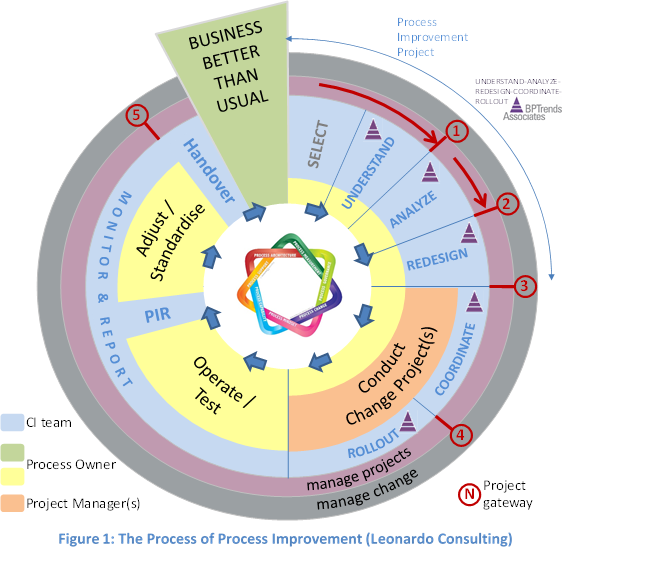
Process Mindset
High levels of BPM maturity can only be achieved and maintained if a process-aware mindset and culture are in play. Making the idea of BPM resonate within an organisation requires deep engagement with the key challenges of contemporary management. If you don’t ‘think process’, you won’t ‘do process’.
The achievement of effective, sustained process-based management is 90% mindset and 10% toolset. Too often we are focused on the 10%, at the expense of the 90%. The tools and techniques are critically important, but they are not the main game. Having the right IT and other tools is a necessary, but nowhere near sufficient, condition for success.
It might be argued that the mindset/toolset emphasis is 80/20, or perhaps even 70/30, rather than 90/10, but it’s certainly not the reverse of any of those. Tools and techniques alone won’t create a viral spread of the idea of BPM. Hearts and minds are also needed.
In a truly process-centric organisation, i.e. an organisation with a high level of BPM Maturity, every employee is conscious of their role in the execution of a range of processes. They are able to think beyond the activities described in their own job description to see their role in the bigger picture of creating, accumulating and delivering value to customers and other stakeholders. The CEO of a large hospital recently surprised staff from the Finance, Operations and IT Departments by telling them that they were also ‘care givers’. He challenged them in this way “if you are working in this hospital and not contributing directly or indirectly to the delivery of care to patients, then what are you doing?”
A process-aware organisational mindset will have the following characteristics. It will be:
• measurement-friendly
• community-focused
• quality-motivated
• change-welcoming
• challenge-addicted
• action-oriented
All six of these attributes are important, but the most important is to be open to performance measurement. One of the most significant roadblocks to robust and sustainable process improvement and management is the absence of a measurement-friendly culture. In an organisation where measurement is a precursor to the allocation of blame, the instinct is to measure as little as possible and to conceal the measures that are unavoidable. Where performance measures are collected to facilitate disparagement, we cannot expect enthusiasm for testing and reporting performance.
A measurement-friendly organisation culture is a prerequisite for the success of process-based management.
During one process-improvement project, a strange conversation with a senior manager occurred. The project team was investigating a process with a customer satisfaction problem, and had developed three change ideas that would significantly increase customer satisfaction at quite low cost. Quite rightly, the team was pleased with its work. However, the senior manager pushed back and found reasons why the changes should not be made. This went on for several days, with the team dispatching each new objection as it came up. Finally, the manager took the project leader aside and explained that his real concern was that if customer satisfaction increased from 83% to 95%, he would get sacked. He was prepared to accept a new target of 85% and that, over time (perhaps a year or two) it might be “safe” to achieve the 95% mark. He was serious. This was a culture of continuous dissembling, not continuous improvement. The organisational mindset was anything but measurement-friendly, and BPM development was inevitably handicapped.
Process Capability
As described in the next section (Process Support), it is not viable to rely on a single central group to do all the process improvement and management work. This model simply does not scale. It is inherently self-limiting in the amount of successful process improvement that can be realised.
If process analysis and improvement is to be part of every employee’s role, they need to be given the opportunity to develop the capabilities to be able to accomplish such tasks successfully. The too common approach of exhorting staff to engage in continuous improvement without giving them the necessary tools and ability to use them is never going to be successful.
What capabilities are required? The following list shows the main elements that staff must understand:
• General principles of BPM
• Process improvement and management methodologies
• Improvement idea generation techniques
• Logistics and purpose of process performance measurement
• Process governance arrangements and accountabilities
• Modelling tools and conventions
• Other related systems
This doesn’t mean that hundreds, or thousands, of staff need to do extensive training courses. For many people these capabilities can be developed to an adequate level via short briefing sessions, published information and participation in process improvement projects.
A BPM development plan is required to outline how the required capabilities will be formed for the various employee groupings.
Process Support
There is a requirement for a centralised support facility. However, it is not the job of any central group to do all of the process work in an organisation. Effective process improvement and management is based on distributed responsibilities and activity. If a central group does all of the process analysis, improvement and management work then, when they are successful, they will not be able to respond quickly to an increasing level of requests for assistance. The central BPM group then becomes the reason that some process improvement work is not being done.
Supporting all of the stakeholders in process management and improvement, ensuring compliance with operational standards and maintaining the central artefacts such as the process architecture is the proper role of a central Office of BPM (aka BPM Centre of Expertise or Centre of Excellence). The main role of such a group is to raise the BPM capabilities of the rest of the organisation.
Many organisations have a long-term goal to create a central business unit tasked to manage, support and nurture BPM throughout the organisation. Most organisations see this as an aspirational goal only achievable once a certain level of BPM maturity has been realised. An alternative view is that the Office of BPM is a catalyst allowing faster and more certain realisation of the significant benefits to be gained from a process support facility.
For many organisations, a gap persists between their aspirations for process-based management and the reality of what is achieved. They strive to get traction with the ideas of BPM, but progress is slow. Creating an Office of BPM can galvanise interest and action and provide a mechanism for effective control and support of the many process initiatives.
In Time
How long does it take to shape all seven enablers into a working BPM system? Assuming there is the required commitment and resources, there are four answers to that question: three weeks, three months, three years, and forever.
Within the first three weeks, initial training and customisation of the basic methodologies is completed. This is a time of preparation both for future project activities and to establish an embryonic, but well informed, process mindset.
Three months should be enough time to get most of the enabler infrastructure in place and to start delivering, or at least clearly identifying, performance improvements. A process architecture and related methods and governance should be available and in use. An Office of BPM, or some other form of central support and compliance management, should be operational. At least one process improvement project should be complete and offering credible performance improvements. That’s a lot to achieve in three months, but the danger in taking longer to deliver tangible developments and practical benefits, is that the organisation will lose interest and commitment will wane.
Creating a new organizational mindset that is process-aware takes much longer. That’s the three year milestone. At that point process awareness should be embedded into day-to-day operations and decision making. This might seem like a long time but genuine culture change does not happen quickly. The three-year anniversary should see a well-developed process architecture, with organisational performance being managed based on process outcomes, all staff regularly and competently in process improvement activities, and well-designed support available to all.
In addition to the above ‘rule of threes’ it is useful to note that many aspects of process-based management are never complete – that’s the ‘continuous’ bit of continuous improvement. The process architecture is never complete, there will always be changes to make to process measures, and there will always be processes to improve. The work goes on; BPM is a management philosophy, not a project.
In summary…
To thrive, perhaps even to survive, in times when ‘doing more with less’ gets harder and harder, we must find another way to think about and deliver value, another way to get the right things done efficiently.
Traditionally, organisations are designed, funded and managed in a functional sense and the key artefact is the organisation chart. The inevitable focus is consequently on managing the entities represented by the boxes on that chart, but none of those can, by themselves, deliver value to external stakeholders.
We create, accumulate and deliver value to customers and other stakeholders by working across the organisation chart. Value is created and delivered by collaboration between the functional entities, i.e. the boxes on the chart. In their important 1990 book , Geary Rummler and Alan Brache described this evocatively as managing the white space on the organisation chart. ( Rummler, Geary A., and A. P. Brache. Improving Performance: how to manage the while space on the organization chart. Jossey-Bass, San Francisco. 1995)
We need both the functional and the process view, but we miss the second view because the money and reporting structure are in the first. Senior executives need to take a step back from the day-to-day functional issues and reimagine their organisations as value creation and delivery flows.
This paper has discussed seven enablers of process-based management, seven elements that will put management focus where it should be, on cross-functional value creation, accumulation and delivery. If you accept the premise that no unit identified on an organisation chart can, by itself, deliver value to an external customer or other stakeholder, (and how could you not do so?) then you accept the main concept of process-based management. The inevitable consequence of that is acceptance of the certainty that processes must be identified, analysed, improved and managed. Since the organisation chart is silent on the management of cross-functional processes, a separate, targeted, and comprehensive intervention is required to enable process-based management and realise the benefits that come from it.
At a time when the requirement to ‘do more with less’ seems both inevitable and impossible, process-based management delivers a practical, proven approach.
Roger Tregear delivers BPM education and consulting assignments, bringing to them 30 years of process and management consulting experience. He spends his working life talking, consulting, thinking, and writing about the discovery, analysis, innovation, improvement, and management of business processes. Having worked in Australia, New Zealand, Bahrain, Belgium, Nigeria, South Africa, South Korea, Saudi Arabia, Jordan, and the United Arab Emirates, Roger has a wealth of experience in diverse cultures, industry sectors, and organization types. A Consulting Director with Leonardo Consulting, Roger is also the Leonardo BPM Practice Director, and is often a presenter at conferences, seminars, and training courses. Roger is a regular columnist for BPTrends (www.bptrends.com), author of Practical Process (2013), and co-author of Establishing the Office of Business Process Management (2011). He contributed the chapter Business Process Standardization in The International Handbook on Business Process Management (Springer, 2010, 2015). With Paul Harmon, he recently edited the book Questioning BPM? published by MKPress in January 2016. A new book, Reimagining Management, will be published later in 2016. Further information about Roger and his published works can be found at the Leonardo website (www.leonardo.com.au), BPTrends, LinkedIn, and Slideshare. Roger can be contacted at r.tregear@leonardo.com.au or on +61 (0)419 220 280.
Copyright © 2016, Roger Tregear, Leonardo Consulting

